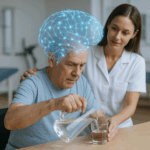Physiotherapy Treatment Protocol for Mild Osteoarthritis of the Knee
Overview of Conditions:
Osteoarthritis (OA) of the knee is a degenerative joint disease that leads to the breakdown of articular cartilage, changes in the underlying bone, and soft tissue remodeling. In the early or mild stage of knee OA, the joint experiences some wear and tear, but significant structural damage is not yet present. Symptoms at this stage typically include mild knee pain, stiffness, and occasional swelling, particularly after physical activity. As OA progresses, symptoms become more pronounced and may include pain at rest, decreased range of motion (ROM), and instability. Mild knee OA can be managed effectively with physiotherapy interventions aimed at relieving pain, improving mobility, and maintaining function.
Assessment and Evaluation:
History:
- The patient often reports mild knee pain, especially after prolonged standing, walking, or physical activity.
- There may be occasional stiffness, particularly after sitting or upon waking.
- Previous history of knee trauma or family history of OA may be present.
Pain Assessment:
- Use tools such as the Visual Analog Scale (VAS) or Numeric Pain Rating Scale (NPRS) to assess pain intensity, focusing on pain during movement and at rest.
- Determine if pain is localized to the knee joint, and its association with activity or time of day.
Physical Examination:
- Postural Assessment: Observe for any malalignment such as varus or valgus deformities.
- Range of Motion (ROM): Assess knee flexion, extension, and rotation. Mild OA typically results in slight loss of extension or flexion.
- Strength Testing: Weakness in the quadriceps and hamstrings may be present due to pain and disuse.
- Swelling/Joint Effusion: Mild swelling or warmth around the joint may be noted, particularly after activity.
- Special Tests:
- McMurray’s Test and Apley’s Test to rule out meniscal tears or cartilage damage.
- Varus/Valgus Stress Test to assess joint stability and ligament integrity.
Goal Setting:
Short-Term Goals:
- Pain Management: Reduce pain intensity to a manageable level (VAS ≤ 3) and minimize inflammation.
- Increase ROM: Maintain or improve knee ROM, especially in extension and flexion.
- Strengthening: Strengthen the quadriceps, hamstrings, and hip stabilizers to support the knee joint.
- Functional Improvement: Improve the ability to perform daily activities, such as walking, standing, and climbing stairs.
Long-Term Goals:
- Prevent Disease Progression: Prevent further joint degeneration and reduce the risk of developing more severe OA.
- Enhance Function: Restore functional independence and enable participation in physical activities.
- Minimize Stiffness: Improve joint mobility and reduce stiffness in the knee joint.
- Pain-free Mobility: Achieve pain-free or minimal pain during weight-bearing activities and functional tasks.
Recommended Treatment:
Electrotherapy:
- Transcutaneous Electrical Nerve Stimulation (TENS):
- Indication: To reduce knee pain, especially after physical activity or in the presence of joint stiffness.
- Parameters:
- Frequency: 80-120 Hz.
- Pulse Width: 100-300 µs.
- Duration: 20-30 minutes, 2-3 times per day.
- Mechanism: TENS provides pain relief by stimulating sensory nerves, which block pain signals to the brain and reduce muscle spasms around the knee joint.
- Interferential Therapy (IFT):
- Indication: To reduce deeper tissue pain and inflammation, particularly in the soft tissues around the knee joint.
- Parameters:
- Frequency: 4,000 Hz carrier frequency modulated at 80-150 Hz.
- Duration: 20-30 minutes per session.
- Mechanism: IFT promotes circulation, reduces inflammation, and relieves muscle pain through deep tissue stimulation.
- Class 4 LASER Therapy:
- Indication: To promote healing, reduce inflammation, and alleviate pain in the knee joint.
- Parameters:
- Wavelength: 800-900 nm.
- Power: 5-10 W.
- Duration: 5-10 minutes per treatment area.
- Mechanism: LASER therapy accelerates tissue repair by stimulating cellular activity, collagen synthesis, and reducing inflammation, which is essential for improving ROM and reducing pain.
- Ultrasound Therapy:
- Indication: For tissue healing and to reduce joint stiffness or muscle tightness around the knee.
- Parameters:
- Frequency: 1 MHz for deep tissue penetration.
- Intensity: 1.0-1.5 W/cm².
- Duration: 8-10 minutes per area.
- Mechanism: Ultrasound therapy helps increase blood flow, reduce inflammation, and enhance tissue healing, which aids in reducing stiffness in OA.
Thermotherapy:
- Moist Heat Packs:
- Indication: To relax muscles around the knee and improve blood circulation before performing exercises.
- Application: Apply for 15-20 minutes before exercise or manual therapy.
- Mechanism: Heat relaxes muscle tissue and increases blood flow, which prepares the knee joint for mobility exercises.
Manual Therapy:
- Joint Mobilization (Grade I-II):
- Indication: To address mild stiffness in the knee joint without exacerbating pain.
- Technique: Perform gentle, pain-free oscillatory mobilizations, especially in the tibiofemoral and patellofemoral joints, to improve joint mobility and reduce pain.
- Mechanism: Joint mobilizations improve synovial fluid movement, increase ROM, and reduce stiffness around the knee joint.
- Myofascial Release:
- Indication: To address muscle tightness, particularly in the quadriceps, hamstrings, and calf muscles, which may contribute to knee pain and reduced mobility.
- Technique: Apply sustained pressure to tight muscle groups followed by gentle stretching to release fascial restrictions.
- Mechanism: Myofascial release improves muscle elasticity, decreases pain, and enhances mobility by addressing soft tissue restrictions.
Exercise Therapy:
- Range of Motion (ROM) Exercises:
- Exercise: Encourage gentle ROM exercises, including knee flexion and extension, to prevent further stiffness.
- Duration: 3-5 sets, 10-15 repetitions, 2-3 times per day.
- Mechanism: ROM exercises help to improve knee joint flexibility, reduce stiffness, and maintain functional movement patterns.
- Strengthening Exercises:
- Exercise: Begin with isometric quadriceps and hamstring exercises, progressing to isotonic strengthening exercises as pain allows.
- Duration: 2-3 sets, 10-12 repetitions, 3 times per week.
- Mechanism: Strengthening the quadriceps, hamstrings, and hip muscles supports the knee joint and improves overall stability, reducing the risk of further injury.
- Low-Impact Aerobic Exercise:
- Exercise: Engage in low-impact activities such as cycling, swimming, or using an elliptical trainer to improve cardiovascular fitness without exacerbating knee symptoms.
- Duration: 20-30 minutes, 3-4 times per week.
- Mechanism: Low-impact aerobic exercises improve overall fitness, maintain joint mobility, and reduce knee stiffness.
- Stretching:
- Exercise: Focus on hamstring, quadriceps, and calf stretches to improve flexibility and reduce muscle tension.
- Duration: Hold each stretch for 20-30 seconds, 2-3 repetitions, 2-3 times per day.
- Mechanism: Stretching helps increase tissue flexibility, reduce muscle tightness, and improve knee ROM.
Precautions:
- Electrotherapy:
- Avoid applying electrotherapy over open wounds or areas of infection.
- Caution with patients who have pacemakers or other implanted devices, as TENS and IFT may interfere with their function.
- Thermotherapy:
- Use heat therapy cautiously in the presence of inflammation or acute injury to avoid exacerbating symptoms.
- Monitor for skin irritation or burns during the application of heat packs.
- Manual Therapy:
- Joint mobilizations should be performed within the patient’s pain tolerance and avoided if joint instability is suspected.
- Apply myofascial release techniques gently to prevent aggravating muscle strain.
- Exercise Therapy:
- Ensure exercises are within the patient’s pain-free range to avoid exacerbating knee discomfort.
- Progress exercises slowly to avoid overloading the joint.
Reassessment and Criteria for Progression/Change in Care Plan:
- Pain Reduction:
- If pain levels remain high (VAS > 3) after 4-6 weeks, consider escalating interventions, including corticosteroid injections or referral for surgical consultation.
- ROM and Function:
- If ROM does not improve after 6 weeks of therapy, consider the addition of more aggressive manual therapy or therapeutic modalities such as high-dose LASER therapy.
- Monitor functional progress through specific tasks like walking, stair climbing, and squatting.
- Strength and Endurance:
- If strength in the quadriceps and hamstrings does not improve after 4-6 weeks of strengthening exercises, re-evaluate the intensity or type of exercise, or refer for further diagnostic workup.
- Patient Education:
- Regularly reassess the patient’s understanding of activity modification and joint protection strategies to prevent disease progression.
References:
- Matzkin, E. G., et al. (2020). “Current Concepts in the Management of Knee Osteoarthritis.” American Journal of Sports Medicine, 48(9), 2280-2290. https://doi.org/10.1177/0363546520906749
- Lonsdale, M. A., et al. (2022). “Exercise Therapy for Knee Osteoarthritis: A Review of Current Evidence.” Journal of Orthopaedic & Sports Physical Therapy, 52(6), 381-394. https://doi.org/10.2519/jospt.2022.10844
- Birrell, F., et al. (2021). “The Efficacy of Physical Therapy Interventions for Osteoarthritis of the Knee: A Systematic Review.” Physical Therapy Reviews, 26(4), 281-290. https://doi.org/10.1080/10833196.2021.1895203
Disclaimer: This content is for informational purposes only. Always consult with a qualified healthcare provider for diagnosis and treatment recommendations tailored to individual needs.






